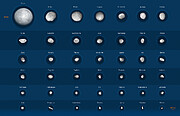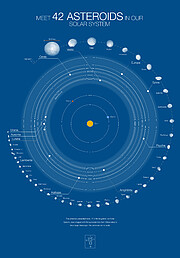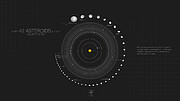Press Release
Meet the 42: ESO images some of the biggest asteroids in our Solar System
12 October 2021

Using the European Southern Observatory’s Very Large Telescope (ESO’s VLT) in Chile, astronomers have imaged 42 of the largest objects in the asteroid belt, located between Mars and Jupiter. Never before had such a large group of asteroids been imaged so sharply. The observations reveal a wide range of peculiar shapes, from spherical to dog-bone, and are helping astronomers trace the origins of the asteroids in our Solar System.
The detailed images of these 42 objects are a leap forward in exploring asteroids, made possible thanks to ground-based telescopes, and contribute to answering the ultimate question of life, the Universe, and everything [1].
“Only three large main belt asteroids, Ceres, Vesta and Lutetia, have been imaged with a high level of detail so far, as they were visited by the space missions Dawn and Rosetta of NASA and the European Space Agency, respectively,” explains Pierre Vernazza, from the Laboratoire d’Astrophysique de Marseille in France, who led the asteroid study published today in Astronomy & Astrophysics. "Our ESO observations have provided sharp images for many more targets, 42 in total."
The previously small number of detailed observations of asteroids meant that, until now, key characteristics such as their 3D shape or density had remained largely unknown. Between 2017 and 2019, Vernazza and his team set out to fill this gap by conducting a thorough survey of the major bodies in the asteroid belt.
Most of the 42 objects in their sample are larger than 100 km in size; in particular, the team imaged nearly all of the belt asteroids larger than 200 kilometres, 20 out of 23. The two biggest objects the team probed were Ceres and Vesta, which are around 940 and 520 kilometres in diameter, whereas the two smallest asteroids are Urania and Ausonia, each only about 90 kilometres.
By reconstructing the objects’ shapes, the team realised that the observed asteroids are mainly divided into two families. Some are almost perfectly spherical, such as Hygiea and Ceres, while others have a more peculiar, “elongated” shape, their undisputed queen being the “dog-bone” asteroid Kleopatra.
By combining the asteroids’ shapes with information on their masses, the team found that the densities change significantly across the sample. The four least dense asteroids studied, including Lamberta and Sylvia, have densities of about 1.3 grams per cubic centimetre, approximately the density of coal. The highest, Psyche and Kalliope, have densities of 3.9 and 4.4 grammes per cubic centimetre, respectively, which is higher than the density of diamond (3.5 grammes per cubic centimetre).
This large difference in density suggests the asteroids’ composition varies significantly, giving astronomers important clues about their origin. “Our observations provide strong support for substantial migration of these bodies since their formation. In short, such tremendous variety in their composition can only be understood if the bodies originated across distinct regions in the Solar System,” explains Josef Hanuš of the Charles University, Prague, Czechia, one of the authors of the study. In particular, the results support the theory that the least dense asteroids formed in the remote regions beyond the orbit of Neptune and migrated to their current location.
These findings were made possible thanks to the sensitivity of the Spectro-Polarimetric High-contrast Exoplanet REsearch (SPHERE) instrument mounted on ESO’s VLT [2]. “With the improved capabilities of SPHERE, along with the fact that little was known regarding the shape of the largest main belt asteroids, we were able to make substantial progress in this field,” says co-author Laurent Jorda, also of the Laboratoire d'Astrophysique de Marseille.
Astronomers will be able to image even more asteroids in fine detail with ESO’s upcoming Extremely Large Telescope (ELT), currently under construction in Chile and set to start operations later this decade. “ELT observations of main-belt asteroids will allow us to study objects with diameters down to 35 to 80 kilometres, depending on their location in the belt, and craters down to approximately 10 to 25 kilometres in size,” says Vernazza. “Having a SPHERE-like instrument at the ELT would even allow us to image a similar sample of objects in the distant Kuiper Belt. This means we’ll be able to characterise the geological history of a much larger sample of small bodies from the ground.”
Notes
[1] In The Hitchhiker's Guide to the Galaxy by Douglas Adams, the number 42 is the answer to the "Ultimate Question of Life, the Universe, and Everything." Today, 12 October 2021, is the 42nd anniversary of the publication of the book.
[2] All observations were conducted with the Zurich IMaging POLarimeter (ZIMPOL), an imaging polarimeter subsystem of the SPHERE instrument that operates at visible wavelengths.
More information
This research was presented in a paper to appear in Astronomy & Astrophysics (https://www.aanda.org/10.1051/0004-6361/202141781).
The team is composed of P. Vernazza (Aix Marseille University, CNRS, CNES, Laboratoire d’Astrophysique de Marseille, France [LAM]), M. Ferrais (LAM), L. Jorda (LAM), J. Hanuš (Institute of Astronomy, Faculty of Mathematics and Physics, Charles University, Prague, Czechia [CU]), B. Carry (Université Côte d’Azur, Observatoire de la Côte d’Azur, CNRS, Laboratoire Lagrange, France [OCA]), M. Marsset (Department of Earth, Atmospheric and Planetary Sciences, MIT, Cambridge, USA [MIT]), M. Brož (CU), R. Fetick (French Areospace Lab [ONERA] and LAM), M. Viikinkoski (Mathematics & Statistics, Tampere University, Finland [TU]), F. Marchis (LAM and SETI Institute, Carl Sagan Center, Mountain View, USA), F. Vachier (Institut de mécanique céleste et de calcul des éphémérides, Observatoire de Paris, PSL Research University, CNRS, Sorbonne Universités, UPMC University Paris 06 and Université de Lille, France [IMCCE]), A. Drouard (LAM), T. Fusco (French Areospace Lab [ONERA] and LAM), M. Birlan (IMCCE and Astronomical Institute of Romanian Academy, Bucharest, Romania [AIRA]), E. Podlewska-Gaca (Faculty of Physics, Astronomical Observatory Institute, Adam Mickiewicz University, Poznan, Poland [UAM]), N. Rambaux (IMCCE), M. Neveu (University of Maryland College Park, NASA Goddard Space Flight Center, US [UMD]), P. Bartczak (UAM), G. Dudziński (UAM), E. Jehin (Space sciences, Technologies and Astrophysics Research Institute, Université de Liège, Belgium [STAR]), P. Beck (Institut de Planetologie et d’Astrophysique de Grenoble, UGA-CNRS, France [OSUG]), J. Berthier (IMCCE), J. Castillo-Rogez (Jet Propulsion Laboratory, California Institute of Technology, Pasadena,USA [JPL]), F. Cipriani (European Space Agency, ESTEC - Scientific Support Office, Noordwijk, The Netherlands [ESTEC]), F. Colas (IMCCE), C. Dumas (Thirty Meter Telescope, Pasadena, USA [TMT]), J. Ďurech (CU), J. Grice (Laboratoire Atmosphères, Milieux et Observations Spatiales, CNRS and Université de Versailles Saint-Quentin-en-Yvelines, Guyancourt, France [UVSQ] and School of Physical Sciences, The Open University, Milton Keynes, UK [OU]), M. Kaasalainen (TU), A. Kryszczynska (UAM), P. Lamy (Departamento de Fisica, Ingeniería de Sistemas y Teoría de la Señal, Universidad de Alicante, Alicante, Spain), H. Le Coroller (LAM), A. Marciniak (UAM), T. Michalowski (UAM), P. Michel (OCA), T. Santana-Ros (Institut de Ciències del Cosmos, Universitat de Barcelona, Spain and European Southern Observatory, Santiago, Chile), P. Tanga (OCA), A. Vigan (LAM), O. Witasse (ESTEC), B. Yang (European Southern Observatory, Santiago, Chile), P. Antonini (Observatoire des Hauts Pays, Bédoin, France), M. Audejean (Observatoire de Chinon, Chinon, France), P. Aurard (AMU, Observatoire de Haute Provence, Institut Pythéas, Saint-Michel l’Observatoire, France [OHP]), R. Behrend (Geneva Observatory, Sauverny, Switzerland and High Energy Physics and Astrophysics Laboratory, Cadi Ayyad University, Marrakech, Morocco [UCA]), Z. Benkhaldoun (UCA), J. M. Bosch (B74, Avinguda de Catalunya 34, 25354 Santa Maria de Montmagastrell (Tarrega), Spain), A. Chapman (Cruz del Sur Observatory, San Justo city, Buenos Aires, Argentina), L. Dalmon (OHP), S. Fauvaud (Observatoire du Bois de Bardon, Taponnat, France and Association T60, Observatoire Midi-Pyrénées, Toulouse, France), Hiroko Hamanowa (Hong Kong Space Museum, Tsimshatsui, Hong Kong, PR China [HKSM]), Hiromi Hamanowa (HKSM), J. His (OHP), A. Jones (I64, SL6 1XE, Maidenhead, UK), D-H. Kim (Korea Astronomy and Space Science Institute, Daejeon, Korea [KASI] and Chungbuk National University, Chungdae-ro, Seowon-gu, Cheongju-si, Chungcheongbuk-do, Korea), M-J. Kim (KASI), J. Krajewski (Faculty of Physics, Astronomical Observatory Institute, Adam Mickiewicz University, Poznań, Poland), O. Labrevoir (OHP), A. Leroy (Observatoire OPERA, Saint Palais, France [OPERA] and Uranoscope, Gretz-Armainvilliers, France), F. Livet (Institut d’Astrophysique de Paris, Paris, France, UMR 7095 CNRS et Sorbonne Universités), D. Molina (Anunaki Observatory, Calle de los Llanos, Manzanares el Real, Spain), R. Montaigut (Club d’Astronomie de Lyon Ampere, Vaulx-en-Velin, France and OPERA), J. Oey (Kingsgrove, NSW, Australia), N. Payre (OHP), V. Reddy (Planetary Science Institute, Tucson, USA), P. Sabin (OHP), A. G. Sanchez (Rio Cofio Observatory, Robledo de Chavela, Spain), and L. Socha (Cicha 43, 44-144 Nieborowice, Poland).
ESO is the foremost intergovernmental astronomy organisation in Europe and the world’s most productive ground-based astronomical observatory by far. It has 16 Member States: Austria, Belgium, Czechia, Denmark, France, Finland, Germany, Ireland, Italy, the Netherlands, Poland, Portugal, Spain, Sweden, Switzerland and the United Kingdom, along with the host state of Chile and with Australia as a Strategic Partner. ESO carries out an ambitious programme focused on the design, construction and operation of powerful ground-based observing facilities enabling astronomers to make important scientific discoveries. ESO also plays a leading role in promoting and organising cooperation in astronomical research. ESO operates three unique world-class observing sites in Chile: La Silla, Paranal and Chajnantor. At Paranal, ESO operates the Very Large Telescope and its world-leading Very Large Telescope Interferometer as well as two survey telescopes, VISTA working in the infrared and the visible-light VLT Survey Telescope. Also at Paranal ESO will host and operate the Cherenkov Telescope Array South, the world’s largest and most sensitive gamma-ray observatory. ESO is also a major partner in two facilities on Chajnantor, APEX and ALMA, the largest astronomical project in existence. And on Cerro Armazones, close to Paranal, ESO is building the 39-metre Extremely Large Telescope, the ELT, which will become “the world’s biggest eye on the sky”.
Links
- Research paper
- Photos of the VLT
- Find out more about ESO's Extremely Large Telescope
- For journalists: subscribe to receive our releases under embargo in your language
- For scientists: got a story? Pitch your research
Contacts
Pierre Vernazza
Laboratoire d’Astrophysique de Marseille
Marseille, France
Tel: +33 4 91 05 59 11
Email: pierre.vernazza@lam.fr
Josef Hanuš
Charles University
Prague, Czechia
Email: josef.hanus@mff.cuni.cz
Laurent Jorda
Laboratoire d’Astrophysique de Marseille
Marseille, France
Tel: +33 4 91 05 69 06
Email: laurent.jorda@lam.fr
Bárbara Ferreira
ESO Media Manager
Garching bei München, Germany
Tel: +49 89 3200 6670
Cell: +49 151 241 664 00
Email: press@eso.org
About the Release
| Release No.: | eso2114 |
| Type: | Solar System : Interplanetary Body : Asteroid |
| Facility: | Very Large Telescope |
| Instruments: | SPHERE |
| Science data: | 2021A&A...654A..56V |
Our use of Cookies
We use cookies that are essential for accessing our websites and using our services. We also use cookies to analyse, measure and improve our websites’ performance, to enable content sharing via social media and to display media content hosted on third-party platforms.
ESO Cookies Policy
The European Organisation for Astronomical Research in the Southern Hemisphere (ESO) is the pre-eminent intergovernmental science and technology organisation in astronomy. It carries out an ambitious programme focused on the design, construction and operation of powerful ground-based observing facilities for astronomy.
This Cookies Policy is intended to provide clarity by outlining the cookies used on the ESO public websites, their functions, the options you have for controlling them, and the ways you can contact us for additional details.
What are cookies?
Cookies are small pieces of data stored on your device by websites you visit. They serve various purposes, such as remembering login credentials and preferences and enhance your browsing experience.
Categories of cookies we use
Essential cookies (always active): These cookies are strictly necessary for the proper functioning of our website. Without these cookies, the website cannot operate correctly, and certain services, such as logging in or accessing secure areas, may not be available; because they are essential for the website’s operation, they cannot be disabled.
Functional Cookies: These cookies enhance your browsing experience by enabling additional features and personalization, such as remembering your preferences and settings. While not strictly necessary for the website to function, they improve usability and convenience; these cookies are only placed if you provide your consent.
Analytics cookies: These cookies collect information about how visitors interact with our website, such as which pages are visited most often and how users navigate the site. This data helps us improve website performance, optimize content, and enhance the user experience; these cookies are only placed if you provide your consent. We use the following analytics cookies.
Matomo Cookies:
This website uses Matomo (formerly Piwik), an open source software which enables the statistical analysis of website visits. Matomo uses cookies (text files) which are saved on your computer and which allow us to analyze how you use our website. The website user information generated by the cookies will only be saved on the servers of our IT Department. We use this information to analyze www.eso.org visits and to prepare reports on website activities. These data will not be disclosed to third parties.
On behalf of ESO, Matomo will use this information for the purpose of evaluating your use of the website, compiling reports on website activity and providing other services relating to website activity and internet usage.
Matomo cookies settings:
Additional Third-party cookies on ESO websites: some of our pages display content from external providers, e.g. YouTube.
Such third-party services are outside of ESO control and may, at any time, change their terms of service, use of cookies, etc.
YouTube: Some videos on the ESO website are embedded from ESO’s official YouTube channel. We have enabled YouTube’s privacy-enhanced mode, meaning that no cookies are set unless the user actively clicks on the video to play it. Additionally, in this mode, YouTube does not store any personally identifiable cookie data for embedded video playbacks. For more details, please refer to YouTube’s embedding videos information page.
Cookies can also be classified based on the following elements.
Regarding the domain, there are:
- First-party cookies, set by the website you are currently visiting. They are stored by the same domain that you are browsing and are used to enhance your experience on that site;
- Third-party cookies, set by a domain other than the one you are currently visiting.
As for their duration, cookies can be:
- Browser-session cookies, which are deleted when the user closes the browser;
- Stored cookies, which stay on the user's device for a predetermined period of time.
How to manage cookies
Cookie settings: You can modify your cookie choices for the ESO webpages at any time by clicking on the link Cookie settings at the bottom of any page.
In your browser: If you wish to delete cookies or instruct your browser to delete or block cookies by default, please visit the help pages of your browser:
Please be aware that if you delete or decline cookies, certain functionalities of our website may be not be available and your browsing experience may be affected.
You can set most browsers to prevent any cookies being placed on your device, but you may then have to manually adjust some preferences every time you visit a site/page. And some services and functionalities may not work properly at all (e.g. profile logging-in, shop check out).
Updates to the ESO Cookies Policy
The ESO Cookies Policy may be subject to future updates, which will be made available on this page.
Additional information
For any queries related to cookies, please contact: pdprATesoDOTorg.
As ESO public webpages are managed by our Department of Communication, your questions will be dealt with the support of the said Department.









